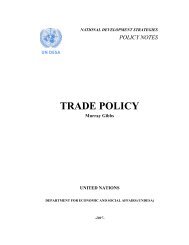SCP in Agriculture and Rural Development
SCP in Agriculture and Rural Development
SCP in Agriculture and Rural Development
You also want an ePaper? Increase the reach of your titles
YUMPU automatically turns print PDFs into web optimized ePapers that Google loves.
for SARD, <strong>and</strong> foster fairer conditions of employment <strong>in</strong> agriculture. It also serves to raise public<br />
awareness of the importance of SARD for achievement of the Millennium <strong>Development</strong> Goals.<br />
There are a wide range of negative impacts result<strong>in</strong>g from conventional agriculture which require<br />
an <strong>in</strong>tegrated, systems-based approach to susta<strong>in</strong>able agriculture <strong>and</strong> rural development, both with<br />
respect to farm management <strong>and</strong> the design <strong>and</strong> application of policies <strong>and</strong> market-based<br />
<strong>in</strong>struments.<br />
L<strong>and</strong> degradation <strong>in</strong> all its forms (<strong>in</strong>clud<strong>in</strong>g depletion of soil nutrients, sal<strong>in</strong>ization, agrochemical<br />
pollution, soil erosion, vegetative degradation due to overgraz<strong>in</strong>g, <strong>and</strong> deforestation) is a threat to<br />
food production <strong>and</strong> rural livelihoods, especially <strong>in</strong> the poorest areas of the develop<strong>in</strong>g world. The<br />
poor are more dependent on agriculture, <strong>and</strong> with<strong>in</strong> agriculture, more dependent on annual crops<br />
<strong>and</strong> on common property which <strong>in</strong>crease pressure on l<strong>and</strong> relative to perennial crops <strong>and</strong> private<br />
property, respectively. The poor are proportionately more affected by l<strong>and</strong> degradation, <strong>and</strong> also<br />
often lack the capacity to undertake l<strong>and</strong>-improv<strong>in</strong>g <strong>in</strong>vestments. This <strong>in</strong>creases poverty as all<br />
forms of l<strong>and</strong> degradation reduce productive capacity <strong>and</strong> thus yields. In turn, this may force<br />
producers to resort to <strong>in</strong>creas<strong>in</strong>g fertilizer use to ma<strong>in</strong>ta<strong>in</strong> yields, ab<strong>and</strong>on some plots of l<strong>and</strong><br />
(temporarily or on a permanent basis), or convert l<strong>and</strong> to lower value crops which can grow on poor<br />
soils or to graz<strong>in</strong>g. 2<br />
In the early n<strong>in</strong>eties, 38% of cropl<strong>and</strong> worldwide was estimated to be degraded to some extent.<br />
The cumulative impact of soil degradation on loss of cropl<strong>and</strong> productivity over the second half of<br />
the twentieth century is estimated to be about 13% (4% for pasture l<strong>and</strong>s). The reduction <strong>in</strong> crop<br />
yields between 1970 <strong>and</strong> 1990 due to water-<strong>in</strong>duced soil erosion alone is estimated to be 8% <strong>in</strong><br />
Africa. While effects on global food supplies are modest, due to the potential for compensation<br />
from non-degraded areas, l<strong>and</strong> degradation could have serious effects <strong>in</strong> certa<strong>in</strong> countries <strong>and</strong><br />
sub-regions <strong>in</strong> the develop<strong>in</strong>g world. 3 In South <strong>and</strong> Southeast Asia, estimates for total annual<br />
economic loss from degradation vary between 1 to 7% of agricultural GDP, while estimates based<br />
on a sample of eight African countries range from 1% of GDP <strong>in</strong> Madagascar to 9% <strong>in</strong> Zimbabwe.<br />
Country models for Ghana <strong>and</strong> Nicaragua estimate that annual GDP growth is reduced by almost<br />
one percentage po<strong>in</strong>t by l<strong>and</strong> degradation. 4<br />
2 Scherr, S.J. <strong>and</strong> S. Yadav (2001), “L<strong>and</strong> degradation <strong>in</strong> the develop<strong>in</strong>g world – Issues <strong>and</strong> policy options for<br />
2020”, Ch.21 <strong>in</strong> The unf<strong>in</strong>ished agenda – Perspectives on overcom<strong>in</strong>g hunger, poverty, <strong>and</strong> environmental<br />
degradation, eds. P<strong>in</strong>strup-Andersen, P. <strong>and</strong> R. P<strong>and</strong>ya-Lorch, IFPRI, 302 pp.<br />
3 For <strong>in</strong>stance, sal<strong>in</strong>ization is a major problem <strong>in</strong> the irrigation systems of the Indus, Tigris <strong>and</strong> Euphrates river<br />
bas<strong>in</strong>s, <strong>in</strong> northeastern Thail<strong>and</strong> <strong>and</strong> Ch<strong>in</strong>a, <strong>in</strong> the Nile Delta, <strong>in</strong> Northern Mexico <strong>and</strong> <strong>in</strong> the Andean highl<strong>and</strong>s,<br />
whereas soil erosion affects with special severity the Himalayan foothills, southern Ch<strong>in</strong>a, Southeast Asia <strong>and</strong><br />
Central America.<br />
4 Scherr, S.J. <strong>and</strong> S. Yadav (2001), “L<strong>and</strong> degradation <strong>in</strong> the develop<strong>in</strong>g world – Issues <strong>and</strong> policy options for<br />
2020”, Ch.21 <strong>in</strong> The unf<strong>in</strong>ished agenda – Perspectives on overcom<strong>in</strong>g hunger, poverty, <strong>and</strong> environmental<br />
degradation, eds. P<strong>in</strong>strup-Andersen, P. <strong>and</strong> R. P<strong>and</strong>ya-Lorch, IFPRI, 302 pp.<br />
2 of 9
















